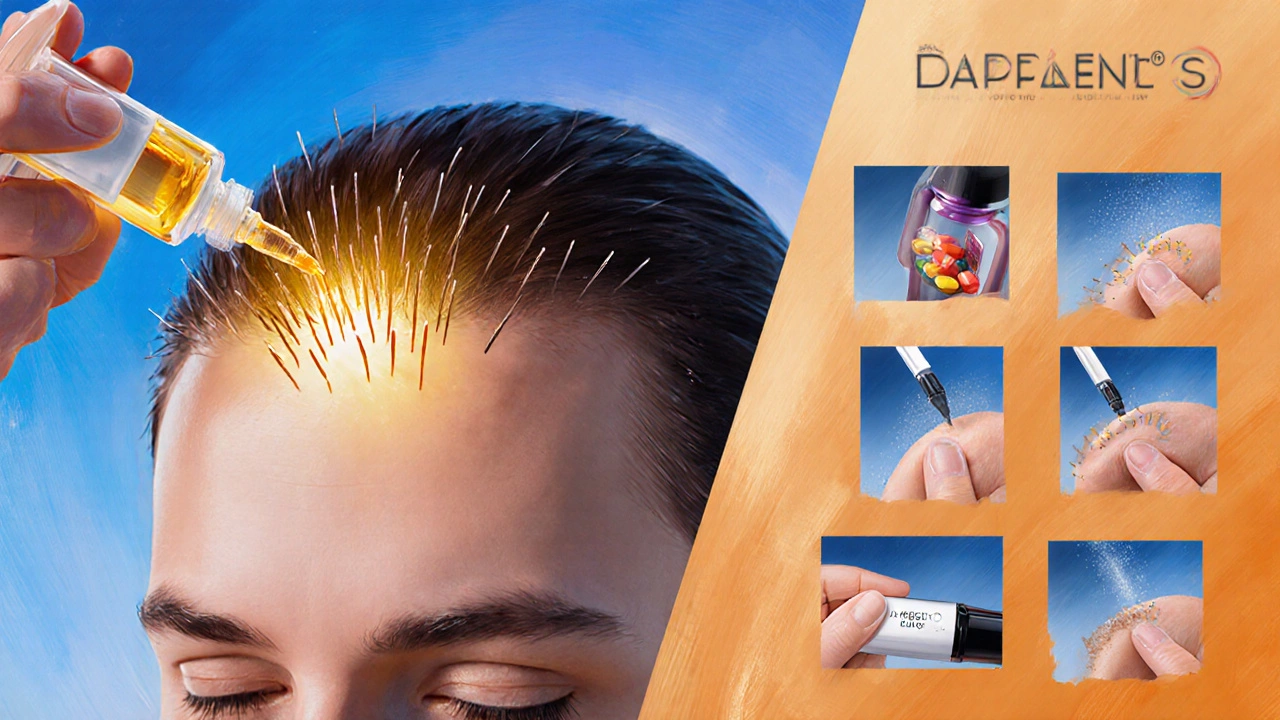Hair Restoration Option Selector
Find the best hair restoration treatment for your unique situation by answering a few questions below.
Recommended Treatment:
If you’re weighing Himplasia against other hair‑restoration options, you’re not alone. Below is a straight‑to‑the‑point comparison that helps you decide which route matches your scalp, budget, and lifestyle.
TL;DR
- Himplasia uses platelet‑rich plasma (PRP) with microneedling; best for early‑stage thinning.
- Minoxidil is the cheapest over‑the‑counter option but requires daily use.
- Finasteride works systemically for male‑pattern baldness; not ideal for women.
- Low‑Level Laser Therapy (LLLT) is painless, at‑home, but slower results.
- Hair transplant offers permanent coverage but is invasive and costly.
What is Himplasia?
Himplasia is a proprietary hair‑restoration protocol that combines platelet‑rich plasma (PRP) injections with microneedling to stimulate dormant follicles. The treatment was launched in 2022 and quickly gained traction in boutique clinics across the U.S. and Europe. By drawing a small amount of your own blood, concentrating platelets, and delivering them into the scalp via a tiny‑needle device, Himplasia aims to jump‑start the body’s natural healing cascade.
Key Related Treatments
Before we dive into the side‑by‑side table, let’s clarify the main alternatives you’ll encounter:
- Platelet‑Rich Plasma (PRP) Therapy is a broader category of treatments that inject concentrated platelets into the scalp without microneedling.
- Microneedling is the use of a dermaroller or automated pen to create micro‑injuries that trigger collagen production and improve product absorption.
- Minoxidil is an FDA‑approved topical solution that widens blood vessels in the scalp, extending the growth phase of hair.
- Finasteride is an oral 5‑α‑reductase inhibitor that reduces dihydrotestosterone (DHT) levels, a primary driver of male‑pattern baldness.
- Low‑Level Laser Therapy (LLLT) is a non‑invasive light‑based method that boosts cellular metabolism in hair follicles.
- Hair Transplant Surgery is a surgical redistribution of healthy follicles from a donor area to thinning zones.
- Nutritional Supplements are vitamins and minerals like biotin, zinc, and vitamin D that support overall hair health.
Side‑by‑Side Comparison
| Attribute | Himplasia | PRP Only | Microneedling + Topicals | Minoxidil | Finasteride | LLLT | Hair Transplant |
|---|---|---|---|---|---|---|---|
| Mechanism | PRP + micro‑injury stimulates follicles | PRP injection without needling | Mechanical injury + drug absorption | Vasodilation, prolongs growth phase | DHT suppression systemically | Photobiomodulation of follicular cells | Permanent relocation of healthy grafts |
| Invasiveness | Minimally invasive (needle depth ~1mm) | Minimally invasive (injection) | Low (dermaroller) + topical | None (topical) | None (oral) | None (device‑based) | Highly invasive (surgical) |
| Typical Cost (US) | $1,200‑$1,800 per series (3‑5 sessions) | $800‑$1,200 per series | $300‑$600 for device + minoxidil | $30‑$60 per month | $30‑$70 per month | $200‑$500 for a home laser cap | $4,000‑$12,000 per graft |
| Session Frequency | Every 4‑6 weeks for 3‑5 sessions, then maintenance every 6‑12 months | Every 4‑6 weeks for 3‑5 sessions | Weekly microneedle + daily topical | Twice daily | Daily oral | 3‑5 minutes daily | One‑time surgery + follow‑up |
| Regulatory Status | FDA‑cleared protocol (clinic‑based) | Off‑label PRP use | Device FDA‑cleared, drugs approved | FDA‑approved | FDA‑approved | FDA‑cleared for hair growth | FDA‑approved for transplantation |
| Typical Results Timeline | 3‑6 months to notice thicker strands | 4‑8 months | 6‑12 months | 4‑6 months for visible regrowth | 3‑9 months | 6‑12 months | Immediate cosmetic coverage; full maturation 9‑12 months |
| Best For | Early‑stage thinning, both genders, desire minimally invasive option | Patients preferring injection only | Budget‑conscious users comfortable with at‑home devices | Those who need a low‑cost, low‑commitment solution | Men with progressive male‑pattern baldness | People seeking painless, daily routine | Advanced balding, desire permanent, can afford surgery |

How to Choose the Right Approach
Everyone’s hair‑loss story is different. Use the checklist below to narrow down the most logical fit.
- Degree of hair loss: If you’re still in the “miniaturization” phase (thinning rather than bald spots), Himplasia or PRP shines.
- Gender considerations: Finasteride is male‑only; women often favor Himplasia, microneedling, or LLLT.
- Budget: Compare upfront costs vs. ongoing expenses. Minoxidil and LLLT have low monthly fees; hair transplant demands a larger single payment.
- Time commitment: Daily topical regimens require discipline; Himplasia needs only a handful of clinic visits.
- Medical tolerance: If you’re on anticoagulants or have needle phobia, a non‑invasive option like LLLT or supplements may be safer.
Pros & Cons at a Glance
- Himplasia: Pros - combines two proven mechanisms, short treatment window, minimal downtime. Cons - higher upfront cost, need for skilled provider.
- PRP Only: Pros - simple injection, widely available. Cons - may lack the added boost from microneedling.
- Microneedling + Topicals: Pros - affordable, can be DIY with proper device. Cons - technique‑sensitive, results vary.
- Minoxidil: Pros - cheap, OTC, easy. Cons - must be used indefinitely, scalp irritation for some.
- Finasteride: Pros - strong evidence for men, oral convenience. Cons - sexual side effects, not for women.
- LLLT: Pros - painless, can be done at home. Cons - slower visible outcomes, device cost.
- Hair Transplant: Pros - permanent, natural‑looking. Cons - surgical risks, expensive, requires donor hair.
Practical Tips for Getting the Most Out of Himplasia
- Choose a clinic with board‑certified dermatologists experienced in PRP.
- Ask about platelet concentration - a 3‑5× boost is ideal.
- Follow post‑procedure care: avoid harsh chemicals for 48hours, keep scalp clean.
- Combine with a gentle, sulfate‑free shampoo to reduce irritation.
- Schedule maintenance sessions as advised; skipping can diminish gains.
Bottom Line: When Himplasia Wins
If you’re in the early stages of thinning, want a treatment that works faster than daily topicals, and don’t mind a modest price tag for a few clinic visits, Himplasia often edges out stand‑alone PRP or microneedling. It also beats finasteride for women and avoids the lifelong commitment that minoxidil demands.
Conversely, if you have extensive baldness, a limited budget, or prefer a completely DIY regimen, laser caps, minoxidil, or a hair transplant may suit you better.
Frequently Asked Questions
How many Himplasia sessions are usually needed?
A typical protocol includes 3‑5 sessions spaced four to six weeks apart. Most patients see noticeable density improvements after the third session, with a maintenance session every 6‑12 months to preserve results.
Is Himplasia safe for women?
Yes. Because the procedure uses the patient’s own blood, there’s no hormonal interference. Many clinics report similar safety profiles for men and women, though pregnant or nursing patients should consult their physician first.
Can I combine Himplasia with minoxidil?
Combining the two is common. Minoxidil can be applied once daily after the PRP window closes (usually 24‑48hours post‑treatment). This hybrid approach may accelerate density gains, but avoid applying both on the same day to reduce irritation.
How does Himplasia differ from standard PRP?
Standard PRP injects platelet‑rich plasma into the scalp without creating micro‑injuries. Himplasia adds a controlled microneedling pass before injection, which opens channels for the growth factors and triggers additional wound‑healing cascades, leading to slightly faster and fuller results.
What are the most common side effects?
Patients usually experience mild redness, swelling, or pinpoint bruising for 1‑2 days. Rarely, there can be temporary scalp tenderness. Side effects resolve without intervention; cold compresses help soothe discomfort.


14 Comments
Dominique Watson
British clinics uphold the highest standards, making Himplasia a superior choice for our lads and lasses alike.
Mia Michaelsen
When you break down the cost‑benefit matrix, Himplasia sits in the mid‑range tier-more expensive than minoxidil but far cheaper than a full transplant. Its mechanism leverages platelet‑derived growth factors plus controlled micro‑injury, which synergistically promotes angiogenesis. The protocol typically requires three to five sessions spaced a month apart, then maintenance annually. Side‑effects are mild-mostly transient erythema and bruising. For patients with early‑stage thinning, the speed of visible density gain often outpaces standalone PRP.
Kat Mudd
I have been following the hair‑restoration market for years and I must say that the hype around Himplasia is not just marketing fluff it is backed by a cascade of biological events that start the moment the needle pierces the scalp it triggers a wound‑healing response that releases cytokines which signal dormant follicles to re‑enter the anagen phase the platelet‑rich plasma adds a concentrated dose of growth factors like PDGF and VEGF that further stimulate vascularization and cell proliferation the combination of micro‑injury and PRP creates a perfect storm for follicular rejuvenation many patients report noticing thicker strands as early as three months while others see incremental improvements up to a year the procedure’s minimally invasive nature means downtime is limited to a day or two and most people can resume normal activities quickly compared to surgical options the cost, while not negligible, is justified when you consider the long‑term savings on daily minoxidil or finasteride prescriptions the safety profile is favorable because it uses autologous blood there is no risk of allergic reaction and serious complications are rare the only notable drawbacks are the need for a qualified practitioner and the fact that results can vary based on individual biology finally, it is worth mentioning that combining Himplasia with a gentle, sulfate‑free shampoo and occasional low‑level laser therapy can amplify outcomes for those who are truly committed to restoring their hair.
Pradeep kumar
From a dermatological perspective, the synergistic effect of microneedling‑induced collagen remodeling and platelet‑derived growth factor release is a textbook example of combinatorial therapy. By creating controlled micro‑channels you enhance tissue permeability, facilitating deeper PRP diffusion and subsequent angiogenic signaling. This protocol aligns with the concept of mechano‑biological transduction, where mechanical stimulus translates into biochemical cascades that reactivate quiescent follicular stem cells. For early‑stage androgenetic alopecia, the risk‑benefit ratio is exceptionally favorable, especially when juxtaposed with systemic anti‑androgens that carry sexual side‑effects. Patients should, however, ensure the clinic adheres to GMP standards for platelet concentration to maximize efficacy.
James Waltrip
Let's be real, the whole Himplasia craze is orchestrated by an elite cabal of dermatology profit‑makers who want to keep us dependent on endless clinic visits. They sprinkle a little PRP and call it miracle while the real money flow is toward proprietary needles that are patented just to lock us in. If you dig deeper, you’ll find that most of the published data are sponsored studies with selective outcome reporting. The average consumer ends up paying for a glossy experience instead of a scientifically proven solution. It’s a classic case of a market‑driven placebo wrapped in a fancy label.
Chinwendu Managwu
Honestly, if you can afford it, just go for Himplasia 😏
Kevin Napier
Appreciate the breakdown above – for anyone on a budget, pairing a modest PRP series with a good quality dermaroller can deliver decent results without blowing your wallet.
Sherine Mary
While the enthusiasm is contagious, it’s worth noting that not every scalp responds uniformly; genetic predisposition still dictates the ceiling of achievable density.
Monika Kosa
Sure, the elite might have a hand in marketing, but the underlying science stands on its own – micro‑injury plus growth factors is a well‑established pathway for tissue regeneration.
Gail Hooks
Hair health is as much cultural as it is biological 🌍💇♀️. Embracing treatments like Himplasia can be a form of self‑care that respects both heritage and modern science.
Derek Dodge
Got my first Himplasia session last month – scalp felt a bit sore but nothing crazy.
AARON KEYS
Just a quick note: the phrase “minimally invasive (needle depth ~1mm)” should read “minimally invasive (needle depth ~1 mm)”. Also, the cost range for LLLT is typically quoted per device, not per cap.
Summer Medina
In reviewing the table I noticed several inconsistencies – the “Typical Cost (US)” column lists a range for PRP only that overlaps with Himplasia, yet the description claims PRP is cheaper. Moreover, the “Regulatory Status” entry for Himplasia says “FDA‑cleared protocol (clinic‑based)” which is misleading because the FDA only cleared the individual components, not a proprietary combo. The “Session Frequency” for minoxidil is stated as “Twice daily” which is accurate but should be qualified with “applied to dry scalp”. Finally, the “Best For” row for LLLT omits mention of scalp type, an important factor for laser penetration.
Melissa Shore
Overall this guide offers a solid comparative framework; readers should weigh early‑stage suitability, budget constraints, and personal tolerance for procedures before deciding on Himplasia or any alternative.